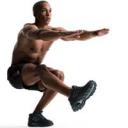1) Bench Dips
Check out the amount of extension you have in your shoulders in a normal range of motion
 Depending on the person, you could have anywhere from 45-60 degrees of extension.
Depending on the person, you could have anywhere from 45-60 degrees of extension.Now check out the amount of extension you get in a bench
 dip:
dip:Most people will go down to a point where the upper arm runs parallel to the floor - about 90 degrees of hyperextension. Now couple that with the fact that your arms are in a position of internal rotation (more on this later) and your scapulae (shoulder blades) are tilted forward in a a very unstable position - you set yourself up for a myriad of shoulder injuries to the rotator cuff or the AC joint.
2) More on the shoulder...Upright Rows.
Impingement of the rotator cuff basically means that the tendons of the rotator cuff are being "pinched" by the head of the humerus and the acromion process when the arm is moved upwards. There are many different reasons as to why this occurs but I don't want this post to be any longer than it needs to be. Here is a simple test to determine impingement syndrome:

Basically the arm is placed in maximum internal rotation (deliberately shortening the space between the head of the humerus and the acromion process) and the elbow is then elevated. If you experience pain in this position - you're likely suffering from impingement syndrome and could lead to rotator cuff tendinopathy if left untreated.
Now take a look at an upright row:
 Do you see the similarities? Horizontal adduction and internal rotation of the humerus coupled with elevation right into the impingement zone. Now explain to me why in the world would anyone want to load this movement pattern with an external load? Your shoulders get more than enough direct work by doing various type of pressing work - the risk is not worth the reward in my opinion.
Do you see the similarities? Horizontal adduction and internal rotation of the humerus coupled with elevation right into the impingement zone. Now explain to me why in the world would anyone want to load this movement pattern with an external load? Your shoulders get more than enough direct work by doing various type of pressing work - the risk is not worth the reward in my opinion.3) Crunches/Situps
Head to any commercial gym and you'll see at least a third of the members performing a billion different types of crunches and sit ups to get that elusive six pack. Everyone has abs - whether or not theyre visible is determined by how much body fat your carrying. But rather than cleaning up their diet and training to be in a state of caloric deficit - these members are convinced that crunching and performing sit ups until they cramp up in their midsection is the key to washboard abs.
Whats the number one way to herniate a disc in your lower back? Repeated compression along with flexion of the lumbar spine. This is exactly what happens when you perform a sit up/crunch. Whats even worse for you low back? Compression with flexion with rotation. Stop doing bicycle crunches and russian twists - your lower back will thank you.
4) Prone Supermans

You also see this one a lot in gyms - members flopping around on their stomachs while wailing on their lower backs. The prone superman places a great deal of shear forces on the lumbar spine. And you wonder why 80% of Americans experience lower back pain at some point in their lives. Furthermore, Mel Siff, in his book Facts and Fallacies of Fitness, states that "Current research has shown that the superman exercise and several of its variations have little or no benefit on back strength and posture." (Siff, p.36) .
The alternating superman is even worse:
 Siff states: "Since the lower extremities are heavier than the upper extremities, this can impose a torque or twisting action around the lumbar spine if the action of the extremities isn't well synchronized and instead of reducing any potential risk of hyperextension, it can add an element of rotation to the extension, thereby making this exercise less safe than controlled gradual simultaneous raising of the legs and arms. In fact, it's not uncommon for this exercise to cause acute back pain and spasm." (Siff, p.36)
Siff states: "Since the lower extremities are heavier than the upper extremities, this can impose a torque or twisting action around the lumbar spine if the action of the extremities isn't well synchronized and instead of reducing any potential risk of hyperextension, it can add an element of rotation to the extension, thereby making this exercise less safe than controlled gradual simultaneous raising of the legs and arms. In fact, it's not uncommon for this exercise to cause acute back pain and spasm." (Siff, p.36)Basically you get the worst of both worlds - not only is it useless, but also extremely unsafe.
5) Last, but not least: Any sort of balancing act on a stability ball, bosu ball, dyna disc, etc for the lower extremity. This one drives me completely insane. It seems like the only prerequisite to be a personal trainer is that some sort of ridiculous balance exercise needs to be included in every single clients workout routine.
 "It's functional and helps balance". How in the world is this functional? Most people cannot perform even a body weight squat properly and when you put an unstable surface underneath them you promote compensation and faulty movement patterns. Add that to the fact that rate of force production decreases because as soon as force is pushed into the surface, it dissipates immediately due to the instability. This means you use less weight, which means less strength, less muscle, less caloric burn, and most importantly diminished results.
"It's functional and helps balance". How in the world is this functional? Most people cannot perform even a body weight squat properly and when you put an unstable surface underneath them you promote compensation and faulty movement patterns. Add that to the fact that rate of force production decreases because as soon as force is pushed into the surface, it dissipates immediately due to the instability. This means you use less weight, which means less strength, less muscle, less caloric burn, and most importantly diminished results.A more functional exercise that challenges balance, stability, and strength: the single leg squat

In this exercise, all your hip stabilizers have to work extremely hard to keep your pelvis in alignment as you squat down. This develops true balance and a great deal of single leg strength. What happens every time you take a step, walk up stairs, sprint, etc.? You're on one leg. How's that for functionality and balance?
Train Hard,
Jason
No comments:
Post a Comment